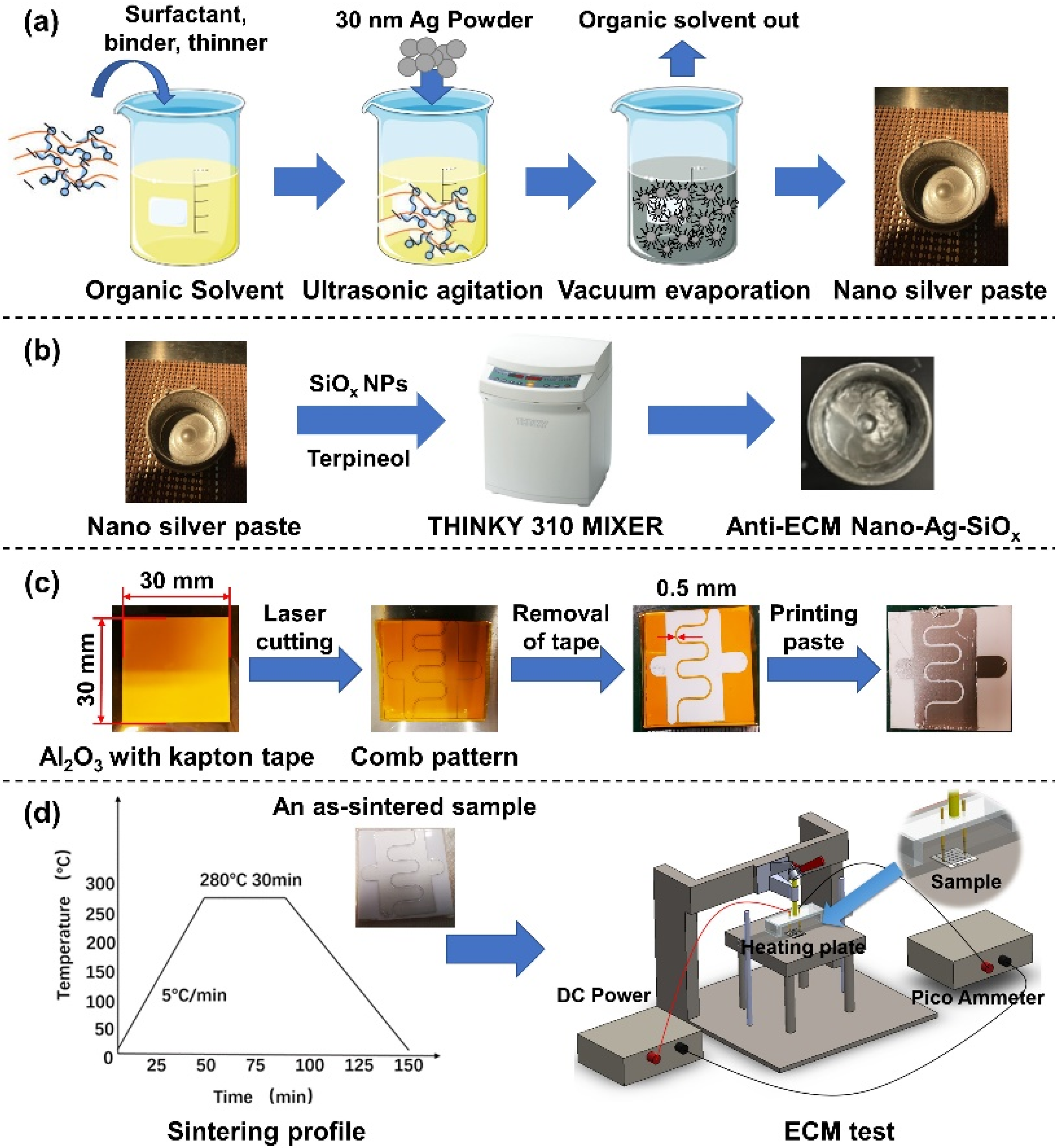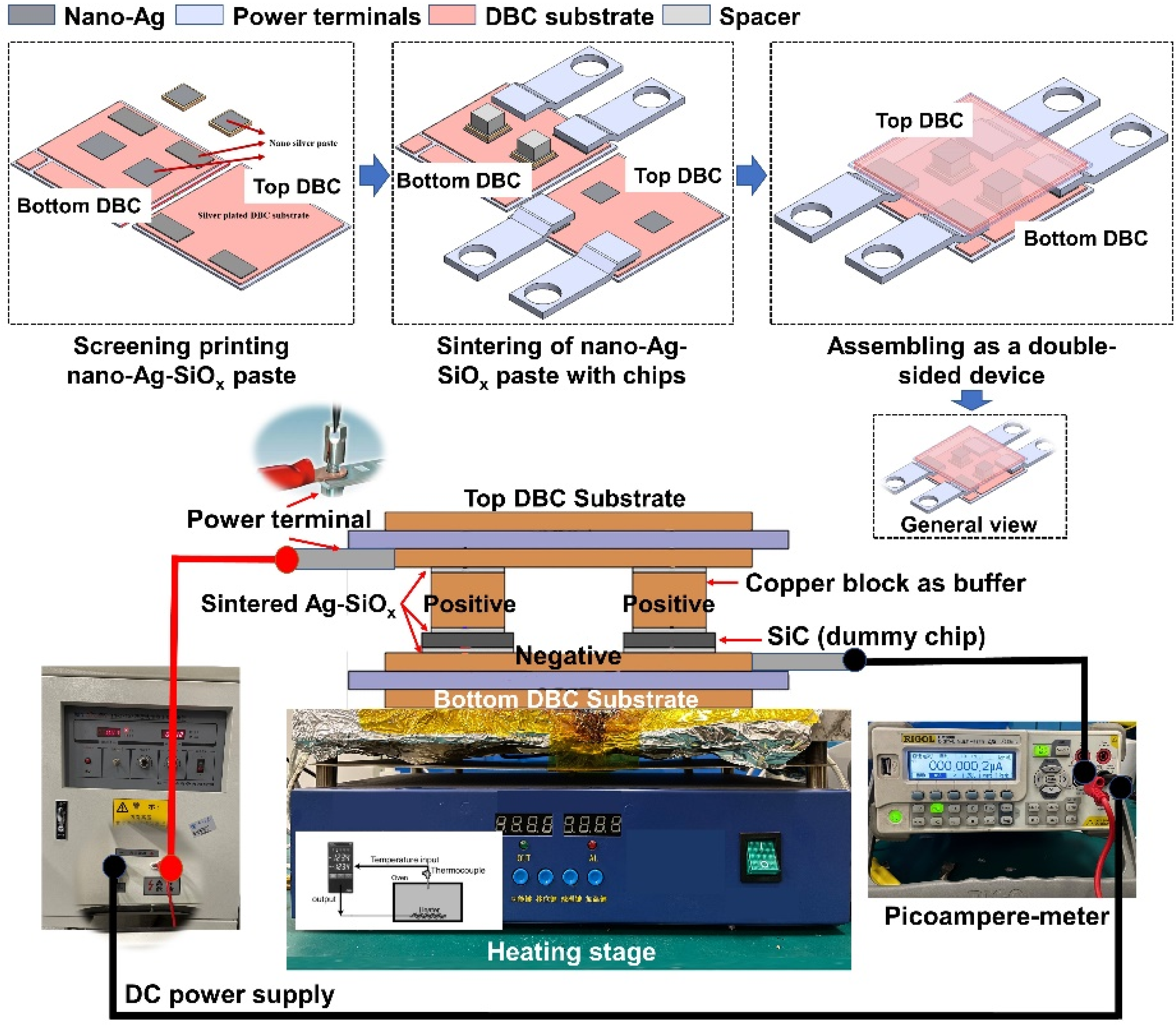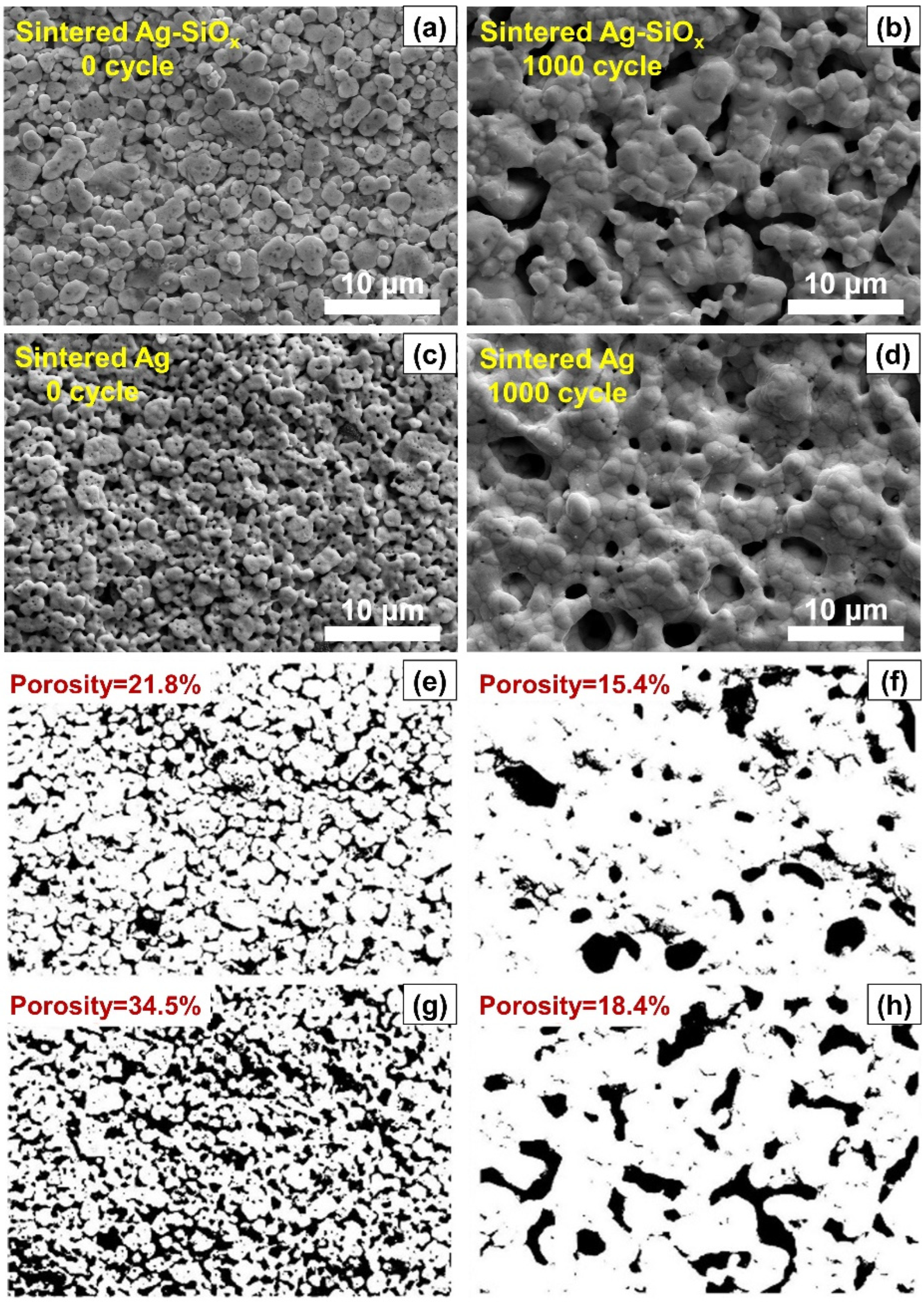A Reliable Way to Improve Electrochemical Migration (ECM) Resistance of Nanosilver Paste as a Bonding Material
Abstract
:1. Introduction
2. Materials and Methods
2.1. Materials
2.2. Methods of Reliability Verification
3. Results and Discussion
4. Conclusions
Author Contributions
Funding
Institutional Review Board Statement
Informed Consent Statement
Data Availability Statement
Acknowledgments
Conflicts of Interest
References
- Wang, T.; Chen, X.; Lu, G.Q.; Lei, G.Y. Low-Temperature Sintering with Nano-Silver Paste in Die-Attached Interconnection. J. Electron. Mater. 2007, 36, 1333–1340. [Google Scholar] [CrossRef]
- Matkowski, P.K.; Falat, T.; Zaluk, Z.; Felba, J.; Moscicki, A. Structure of the Thermal Interface Connection Made of Sintered Nano Silver. In Proceedings of the 2014 IEEE Electronics System-Integration Technology Conference, Dresden, Germany, 7–11 May 2014; pp. 1–6. [Google Scholar]
- Yang, C.A.; Kao, C.R.; Nishikawa, H. Development of Die Attachment Technology for Power IC Module by Introducing Indium into Sintered Nano-Silver Joint. In Proceedings of the 2017 IEEE 67th Electronic Components and Technology Conference (ECTC), Orlando, FL, USA, 30 May–2 June 2017; pp. 2377–5726. [Google Scholar]
- Kim, K.S.; Bang, J.O.; Jung, S.B. Electrochemical Migration Behavior of Silver Nanopaste Screen-Printed for Flexible and Printable Electronics. Curr. Appl. Phys. 2013, 13, S190–S194. [Google Scholar] [CrossRef]
- Yang, S.; Christou, A. Failure Model for Silver Electrochemical Migration. IEEE Trans. Device Mater. Reliab. 2007, 7, 188–196. [Google Scholar] [CrossRef]
- Noh, B.I.; Yoon, J.W.; Kim, K.S.; Lee, Y.C.; Jung, S.B. Microstructure, Electrical Properties, and Electrochemical Migration of a Directly Printed Ag Pattern. J. Electron. Mater. 2011, 40, 35–41. [Google Scholar] [CrossRef]
- Li, D.; Mei, Y.H.; Tian, Y.; Xin, Y. Doping Low-Cost SiOx (1.2 < x < 1.6) Nanoparticles to Inhibit Electrochemical Migration of Sintered Silver at High Temperatures. J. Alloys Compd. 2020, 830, 154587. [Google Scholar]
- Medgyes, B.; Illés, B.; Harsányi, G. Electrochemical Migration Behaviour of Cu, Sn, Ag and Sn63/Pb37. J. Mater. Sci. Mater. Electron. 2012, 23, 551–556. [Google Scholar] [CrossRef]
- Mei, Y.H.; Lu, G.Q.; Chen, X.; Luo, S.; Ibitayo, D. Migration of Sintered Nanosilver Die-Attach Material on Alumina Substrate Between 250 °C and 400 °C in Dry Air. IEEE Trans. Device Mater. Reliab. 2011, 11, 316–322. [Google Scholar] [CrossRef]
- Mcnutt, T.; Passmore, B.; Fraley, J.; Mcpherson, B.; Shaw, R.; Olejniczak, K.; Lostetter, A. High-Performance, Wide-Bandgap Power Electronics. J. Electron. Mater. 2014, 43, 4552–4559. [Google Scholar] [CrossRef]
- Zhou, Y.; Huo, Y. The Comparison of Electrochemical Migration Mechanism between Electroless Silver Plating and Silver Electroplating. J. Mater. Sci. Mater. Electron. 2016, 27, 931–941. [Google Scholar] [CrossRef]
- Liu, X.; Wu, Z.; Yan, Y.; Kang, Y.; Chen, C. A Novel Double-Sided Cooling Inverter Leg for High Power Density EV Based on Customized SiC Power Module. In Proceedings of the 2020 IEEE Energy Conversion Congress and Exposition (ECCE), Detroit, MI, USA, 11–15 October 2020; pp. 3151–3154. [Google Scholar]
- Cheng, T.H.; Nishiguchi, K.; Fukawa, Y.; Baliga, B.J.; Hopkins, D.C. Characterization of Highly Thermally Conductive Organic Substrates for a Double-Sided Cooled Power Module. Int. Symp. Microelectron. 2020, 1, 277–281. [Google Scholar] [CrossRef]
- Yang, C.A.; Wu, J.; Lee, C.C.; Kao, C.R. Analyses and Design for Electrochemical Migration Suppression by Alloying Indium into Silver. J. Mater. Sci. Mater. Electron. 2018, 29, 13878–13888. [Google Scholar] [CrossRef] [Green Version]
- Zhang, D.; Zou, G.; Liu, L.; Zhang, Y.; Yu, C.; Bai, H.; Zhou, N. Synthesis with Glucose Reduction Method and Low Temperature Sintering of Ag-Cu Alloy Nanoparticle Pastes for Electronic Packaging. Jpn. Inst. Met. Mater. 2015, 56, 1252–1256. [Google Scholar] [CrossRef] [Green Version]
- Wang, D.; Mei, Y.H.; Xie, H.; Zhang, K.; Siow, K.S.; Li, X.; Lu, G.Q. Roles of Palladium Particles in Enhancing the Electrochemical Migration Resistance of Sintered Nano-Silver Paste as a Bonding Material. Mater. Lett. 2017, 206, 1–4. [Google Scholar] [CrossRef]
- Bai, J.G.; Calata, J.N.; Lu, G.Q. Processing and Characterization of Nanosilver Pastes for Die-Attaching SiC Devices. IEEE Trans. Electron. Packag. Manuf. 2007, 30, 241–245. [Google Scholar] [CrossRef]
- Gang, C.; Dan, H.; Mei, Y.H.; Cao, X.; Tao, W.; Xu, C.; Lu, G.Q. Transient Thermal Performance of IGBT Power Modules Attached by Low-Temperature Sintered Nanosilver. IEEE Trans. Device Mater. Reliab. 2012, 12, 124–132. [Google Scholar]
- Mei, Y.; Tao, W.; Xiao, C.; Gang, C.; Lu, G.Q.; Xu, C. Transient Thermal Impedance Measurements on Low-Temperature-Sintered Nanoscale Silver Joints. J. Electron. Mater. 2012, 41, 3152–3160. [Google Scholar] [CrossRef]
- Li, D.; Mei, Y.; Xin, Y.; Li, Z.; Chu, P.K.; Ma, C.; Lu, G.Q. Reducing Migration of Sintered Ag for Power Devices Operating at High Temperature. IEEE Trans. Power Electron. 2020, 35, 12646–12650. [Google Scholar] [CrossRef]
- Wazzan, A.R.; Tung, p.; Robinson, L.B. Diffusion of Silver into Nickel Single Crystals. J. Appl. Phys. 1971, 42, 5316–5320. [Google Scholar] [CrossRef]
- Friedland, E.; Malherbe, J.B.; van der Berg, N.G.; Hlatshwayo, T.; Botha, A.J.; Wendler, E.; Wesch, W. Study of Silver Diffusion in Silicon Carbide. J. Nucl. Mater. 2009, 389, 326–331. [Google Scholar] [CrossRef]
- Hu, B.; Yang, F.; Peng, Y.; Hang, C.; Chen, H.; Lee, C.; Yang, S.; Li, M. Effect of SiC Reinforcement on the Reliability of Ag Nanoparticle Paste for High-Temperature Applications. J. Mater. Sci. Mater. Electron. 2019, 30, 2413–2418. [Google Scholar] [CrossRef]
- Zhang, H.; Chen, C.; Nagao, S.; Suganuma, K. Thermal Fatigue Behavior of Silicon-Carbide-Doped Silver Microflake Sinter Joints for Die Attachment in Silicon/Silicon Carbide Power Devices. J. Electron. Mater. 2017, 46, 1055–1060. [Google Scholar] [CrossRef]
- Yan, H.; Liang, P.; Mei, Y.H.; Feng, Z. Brief Review of Silver Sinter-bonding Processing for Packaging High-temperature Power Devices. Chin. J. Electr. Eng. 2020, 6, 25–34. [Google Scholar] [CrossRef]
- Li, W.; Hu, D.; Li, L.; Li, C.F.; Jiu, J.; Chen, C.; Ishina, T.; Sugahara, T.; Suganuma, K. Printable and Flexible Copper-Silver Alloy Electrodes with High Conductivity and Ultrahigh Oxidation Resistance. ACS Appl. Mater. Inter. 2017, 9, 24711–24721. [Google Scholar] [CrossRef] [PubMed]
- Lin, S.K.; Nagao, S.; Yokoi, E.; Oh, C.; Zhang, H.; Liu, Y.C.; Lin, S.G.; Suganuma, K. Nano-Volcanic Eruption of Silver. Sci. Rep. 2016, 6, 34769. [Google Scholar] [CrossRef]





| Temperature (K) | Electrode Spacing (mm) | Voltage (V) | Lifetime (min) | |
|---|---|---|---|---|
| Sintered Nano-Ag | Sintered Nano-Ag-SiOx | |||
| 673 | 0.5 | 200 | 332 | 512 |
| 673 | 0.5 | 260 | 294 | 477 |
| 673 | 0.5 | 300 | 236 | 412 |
| 773 | 0.5 | 200 | 134 | 341 |
| 773 | 0.5 | 260 | 81 | 244 |
| 773 | 0.5 | 300 | 74 | 208 |
Publisher’s Note: MDPI stays neutral with regard to jurisdictional claims in published maps and institutional affiliations. |
© 2022 by the authors. Licensee MDPI, Basel, Switzerland. This article is an open access article distributed under the terms and conditions of the Creative Commons Attribution (CC BY) license (https://creativecommons.org/licenses/by/4.0/).
Share and Cite
Ding, Z.; Wang, Z.; Zhang, B.; Lu, G.-Q.; Mei, Y.-H. A Reliable Way to Improve Electrochemical Migration (ECM) Resistance of Nanosilver Paste as a Bonding Material. Appl. Sci. 2022, 12, 4748. https://doi.org/10.3390/app12094748
Ding Z, Wang Z, Zhang B, Lu G-Q, Mei Y-H. A Reliable Way to Improve Electrochemical Migration (ECM) Resistance of Nanosilver Paste as a Bonding Material. Applied Sciences. 2022; 12(9):4748. https://doi.org/10.3390/app12094748
Chicago/Turabian StyleDing, Zikun, Zhichao Wang, Bowen Zhang, Guo-Quan Lu, and Yun-Hui Mei. 2022. "A Reliable Way to Improve Electrochemical Migration (ECM) Resistance of Nanosilver Paste as a Bonding Material" Applied Sciences 12, no. 9: 4748. https://doi.org/10.3390/app12094748





